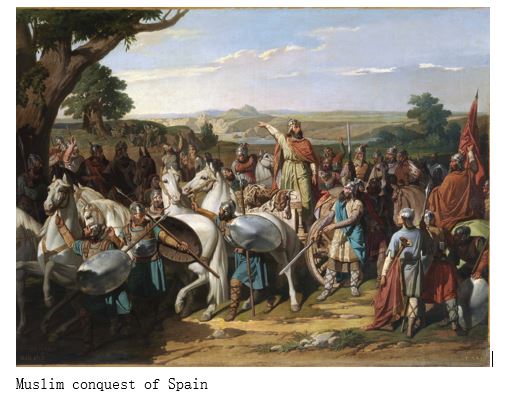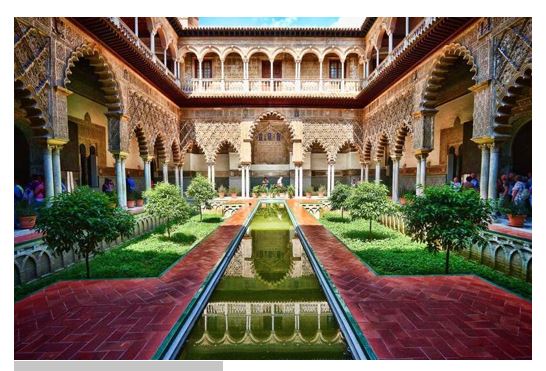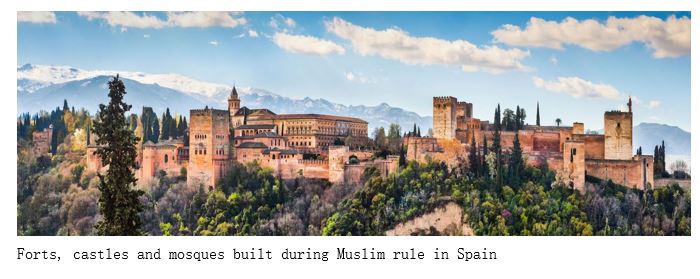By Latheef Farook
More than four centuries of Muslim rule in Spain is regarded as the golden era of Islamic history. On April 30, 711, Muslim General Tariq ibn-Ziyad landed at Gibraltar and brought Iberian Peninsula under Islamic rule. Since then Iberian peninsula has became one of the great Muslim civilisations; reaching its summit with the Umayyad caliphate of Cordova in the tenth century.
However Muslim rule declined after that and ended in 1492 when Granada was conquered .Often described as a ‘golden age’ of learning in Spain, Muslim rule is where libraries, colleges, public baths were established and literature, poetry and architecture flourished.
According to historian Jean Batou “ for half a millennium, modern-day Spain was mostly ruled by Muslim kingdoms that presided over an extraordinary cultural experiment. This Empire added contributions to society in fields such as libraries, schools, public bathrooms, literature, poetry, and architecture. This work was mainly developed through the unification of people of all faiths.
While the three major monotheistic religious traditions certainly did borrow from one another in Al-Andalus, benefiting especially by the blooming of philosophy and the medieval sciences in the Muslim Middle East, scholarship has brought into question the notion that the peaceful coexistence of Muslims, Jews, and Christians — could be defined as “pluralistic.”
People of other religions could contribute to society and the culture developed in this time. One of the reasons for such great success under this empire was the legal terms offered to the public, which differed from the conditions which were implemented by the Visigoth kingdom which preceded it .
The key to understanding Al-Andalus lies in its unorthodox social structure and its political location between two worlds. For half a millennium, the Iberian Peninsula represented a significant part of the Muslim world — of its population, economy, political power and culture.
If you’re wondering, “Which part of Spain has Islamic history?”, the answer is none other than Andalusia, Southern Spain. A solo trip to Andalusia is simply incomplete without visiting Andalusia’s Islamic Heritage, such as The Alhambra, and Cordoba Mezquita, to name a few.
Al-Andalus became the first laboratory for a form of Arab-Muslim domination which had renounced conquest to bet on the economic development of its territory. This evolution tended to gradually win over the natives to the language, culture, and beliefs of the Arabs without excessive pressure.
According to Jean Batou A century after its birth in the western Arabian Peninsula at the beginning of the seventh century, Islam had conquered the Middle East, Africa, and part of Southern Europe. This vibrant, expanding religion had established its western outpost in Spain and Portugal. What followed may be surprising to those familiar with the history of medieval religious polities on both sides of the Mediterranean. Here more than elsewhere in the Muslim world — not to mention the Christian states of Europe — minority faiths enjoyed a degree of toleration. Christians and Jews were able to continue to practice their faith, sometimes even alongside Muslims.
The Holy Koran advocated acceptance of what Prophet Mohammed (PBUH) called other “religions of the Book,” such as Christianity and Judaism. In this region called Al-Andalus, this fluctuating tolerance — sometimes quite exceptional in its scope, was combined with extensive mutual cultural borrowings over a long period. Some authors have gone so far as to speak of a genuine Andalusian Enlightenment.
In a Europe where the role of Islam, past and present, is a matter of bitter political controversy, the experience of Al-Andalus continues to fascinate those who have studied its history. In the second half of the tenth century, the Muslim world represented almost a fifth of the world’s population, according to the best estimates we can make. Its eastern part, from Iraq to Tajikistan, was populated by fifteen to twenty million inhabitants, subject to the spiritual authority of the Sunni Abbasid caliphs.
Spain has a long history of Islamic tradition under its belt. From cuisine to architecture, the southern European country has been linked to the North of Africa through many common elements. At the end of 2019, there were approximately 2.1 million Muslims in Spain, . With a Muslim population of more than 560 thousand people, Catalonia was home to the largest Muslim community in Spain as of the same date.
Arab civilization in the peninsula reached its zenith when the political power of the Arabs began to decline. Immediately following the Muslim conquest in the 8th century, there were no traces of a cultural level higher than that attained by the Mozarabs who lived among the Arab conquerors. All available evidence points to the fact that in this period popular works of medicine, agriculture, astrology, and geography were translated from Latin into Arabic.
In the 9th century the situation changed abruptly: the Andalusians, who traveled east in order to comply with the injunction to conduct a pilgrimage to Mecca at least once in their lifetimes, took advantage of their stay in those regions to enhance their knowledge, which they then introduced into their native country.
The Caliphate of Córdoba thus became a crucial partner in Mediterranean trade, with links to North Africa, the trans-Saharan gold trade, and Southern Italy, Byzantium, and Egypt. Its resources had grown enormously.In the second half of the tenth century, the Muslim world represented almost a fifth of the world’s population.
The new commander of the believers demonstrated his undisputed leadership by building the luxurious palatial city of Madinat al-Zahra, on the outskirts of Córdoba, with a combined population of up to three hundred fifty thousand.
Today Spain is a Christian majority country, with Islam being a minority religion, practised mostly by immigrants from Muslim majority countries, and their descendants. As of 2019, 4.45% of the Spanish population are Muslims.
Muslim conquest of Spain



Granada’s Alhambra complex is without doubts the architectonic and artistic Muslim landmark in Spain. It is the best Arab palace in the world and one of the world’s most spectacular monuments that exudes beauty in each of its halls and yards. The residence of the Nasrid Kingdom created a space for the pleasure of the senses, in which harmony and the refinement of the design and the decoration of Muslim civilization reached almost unparalleled levels of perfection.

Post Disclaimer
Disclaimer: Muslim Spain- Crucial Part of Europe’s History - Views expressed by writers in this section are their own and do not necessarily reflect Latheefarook.com point-of-view